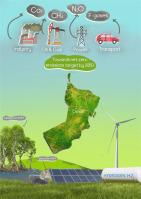Oman's energy transition roadmap to net zero 2050
IF 9.5
Q1 ENERGY & FUELS
引用次数: 0
Abstract
The net zero target has been established due to the increased rate of greenhouse gas emissions, which has caused the global temperature to increase above historical levels prior to the pre-industrial revolution. Many countries and governments have therefore worked to create strategic plans for achieving net zero emissions by 2050 and 2060. Oman is one country to have announced its national determined contribution for the agreement. This paper describes the plan, strategy, and efforts that have been established for that target. The main aims were to compile the strategies and progress of energy transition in Oman and to study the alignment of the transition plan with the standard net zero goal. Oman has selected an orderly transition pathway, which meets all the net zero plan objectives to optimize long-term economic gain and environmental impact while achieving a carbon budget of 1760 MtCo2 per annum. Different decarbonization plans are set for each sector, with remaining emissions to be addressed in last-mile reduction. The electricity sector has just started progress toward achieving 57 % reduction by 2040 and 99 % by 2050. Extending the net zero plan to cover all footprints and nexuses will elevate its scale, and is necessary to achieve the sustainable development goals. To the best of our knowledge, this is the first article dedicated to illuminating the energy transition toward Oman's net zero 2050 emissions plan.

阿曼的能源转型路线图到2050年净零
由于温室气体排放量的增加,导致全球气温高于工业革命前的历史水平,因此建立了净零目标。因此,许多国家和政府都在努力制定战略计划,以在2050年和2060年之前实现净零排放。阿曼是宣布为该协定作出国家自主贡献的国家之一。本文描述了为实现这一目标而制定的计划、策略和努力。主要目的是汇编阿曼能源转型的战略和进展,并研究转型计划与标准净零目标的一致性。阿曼选择了一条有序的过渡路径,该路径符合所有净零计划目标,以优化长期经济收益和环境影响,同时实现每年1760亿吨二氧化碳的碳预算。每个行业都制定了不同的脱碳计划,剩余的排放将在最后一英里的减排中得到解决。电力行业刚刚开始朝着到2040年减排57%和到2050年减排99%的目标迈进。将净零计划扩大到涵盖所有足迹和联系,将提升其规模,并且是实现可持续发展目标的必要条件。据我们所知,这是第一篇致力于阐明阿曼2050年净零排放计划的能源转型的文章。
本文章由计算机程序翻译,如有差异,请以英文原文为准。
求助全文
约1分钟内获得全文
求助全文
来源期刊

Energy nexus
Energy (General), Ecological Modelling, Renewable Energy, Sustainability and the Environment, Water Science and Technology, Agricultural and Biological Sciences (General)
CiteScore
7.70
自引率
0.00%
发文量
0
审稿时长
109 days
 求助内容:
求助内容: 应助结果提醒方式:
应助结果提醒方式:


